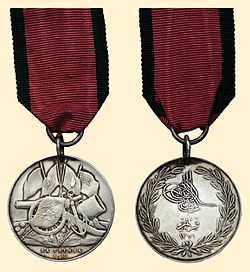Turkish Crimean War medal
| Turkish Crimea Medal | |
|---|---|

Turkish Crimean War Medal reverse (left) and obverse. Sardinian issue as the flags show.
|
|
| Awarded by the |
|
| Type | Campaign medal |
| Eligibility | British, French, or Sardinian personnel |
| Campaign(s) | Crimean War |
| Statistics | |
| Established | 1856 |
| Distinct recipients |
20,000 |
|
Ribbon bar of the medal |
|
The Turkish Crimean War Medal (Turkish: Kırım Harbi Madalyası) is a campaign medal issued by Sultan Abdülmecid I of the Ottoman Empire to allied military personnel involved in the Crimean War of 1854–56. There are three different issues of this medal for those issued to British, French, or Sardinian personnel. The medal was designed by James Robertson.
The obverse shows the Ottoman Sultan’s tughra with the Muslim calendar year of 1271 on all versions. The reverse depicts a cannon standing upon the Imperial Russian flag, an anchor and a mortar. There are four flags to the rear of these three items which can be used to identify the country to which the medal was intended. This will be for either a soldier from Great Britain, or France, or Sardinia. The identifying flag is the central right hand flag, positioned above the anchor. It is a Union Flag for Great Britain, the tricolour for France and the flag of the Kingdom of Italy for Sardinia, based on the Italian tricolore. Since Sardinia was ruled at the time by the House of Savoy, this flag has the shield shaped emblem of the Savoy coat of arms in the central panel of the Italian tricolore.
Note that due to the loss by shipwreck of many of these medals intended for British recipients, awards were made with whatever issue came to hand, the most common being of the Sardinian type.
Additionally, the inscription in the exergue reads "Crimea 1855" for British issue, "La Crimee 1855" for French issue, and "La Crimea 1855" for Sardinian issue.
The ribbon itself is watered and of dark crimson with green edges. The original ribbon issued with this medal measured only .50” wide (rather like a miniature medal ribbon) and often used two widths, but it was usually replaced by one of 1.25” when awarded to British personnel. The medal was originally worn via one or two very small steel rings, although the one on the medal itself can be silver. Not only did they tend to rust, but these rings were almost universally altered to take the wider ribbon conforming to standard British type. Other suspensions were also used and therefore many medals are found with a privately attached scroll or other suspender akin to British medal types. Such medals are still considered contemporary and the alterations do not alter their value.
...
Wikipedia
